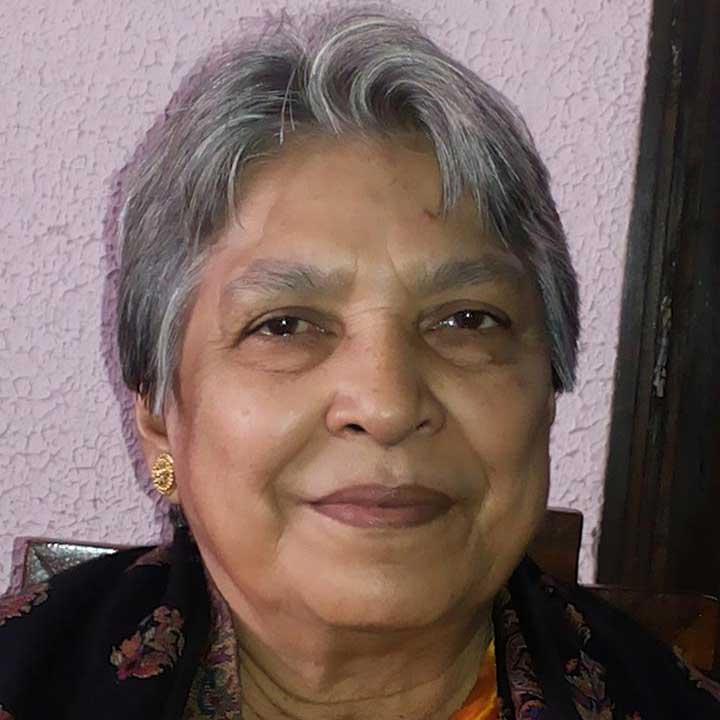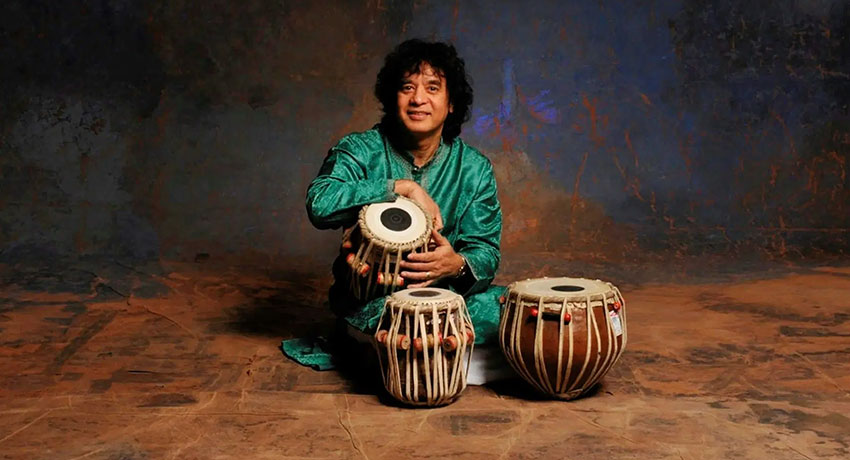Unlike other years, the Guru Kelucharan Mohapatra Award giving festival was a week long. It was the silver jubilee celebrations of a festival that started in the year 1995. Bhajan singer Anup Jalota singing ‘Aisi Lage lagan Meera ho gai magan woh tho gali gali Hari gun gane lagi’ in his inimitable fashion, with audience involvement right at the start, set the mood of the festival. Pradip Ghosh, Rashid Khan and Himanshu Tewari were the happy accompanists supporting him on tabla, violin and guitar added to the mood of the evening. Other popular and hit numbers followed one after the other.
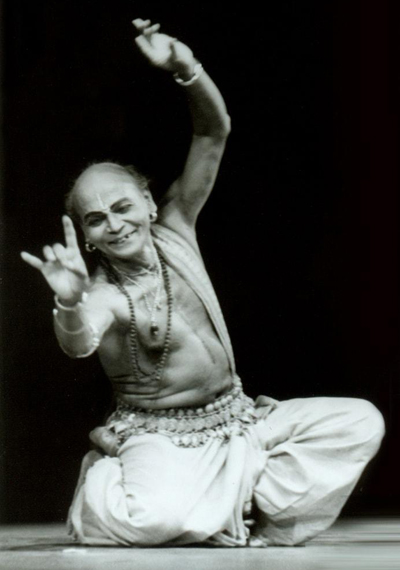
After Anup Jalota’s soulful singing, Gunjan Dance Academy, the dance institution of senior Odissi exponent Meera Das performed a pure dance piece with her disciples. Stage space was well utilised with permutation and combination of her very well trained group of six, going in and out like buds blossoming. Meera was a co-dancer and added to the beauty of the piece. Dasavatar in raag Kalyan –a composition of the legendary duo- Kelucharan Mohapatra and Bhubaneswar Mishra –in champa taal was rearranged with imagination by Meera Das. It is given that a composition by two stalwarts if performed with a certain amount of sincerity would be a sure hit and so it was. A very apt start was contributed by taking the pose of Anantasayana of Lord Padmanabha.
The festival moved to the 6th of September. Ratikant Mohapatra, Director-Srjan, following the set pattern for the Award Festival this year, commenced each day with a music recital, followed by a group presentation. Each evening had two established groups of Odisha perform. Classical Music Fusion presentation by Flautist Paras Nath, Violinist Deepak Pandit, and ‘Mandolin’ Rajesh, accompanied on the Tabla by Prashant Sonagra, who began with a special tribute to the legendary Guru Kelucharan Mohapatra, in whose honour the festival is being organised. The whole evening was based on a variety of classical ragas in a seamless amalgamation of neat articulations and complex musical patterns.
While grounded in the classical tradition. The musicians explored novel interpretations of the ragas and the highlight of their presentation was the final piece, set to Ragamaalika. A single composition featuring 14 different ragas, the piece began in the afternoon Raga Bhimpalasi, captivating the audience with their versatility and creative expression. They created a musical harmony that reverberated in the hall. Thereafter, Suravi, led by Pitambar Biswal presented Suryashtaka, a hymn in praise of Lord Surya invoking blessings of good health, abundance and longevity and to absolve mankind from sufferings, praying for a harmonious life. The dancers, with neat and fluid movements and confidence, portrayed various facets of the Sun God. Surya Pranam provided visual beauty. Set to the music composition of Ramhari Das, the rhythm composition of Niranjan Patra, the original dance choreography by Guru Durga Charan Ranbir was adapted into a group composition.
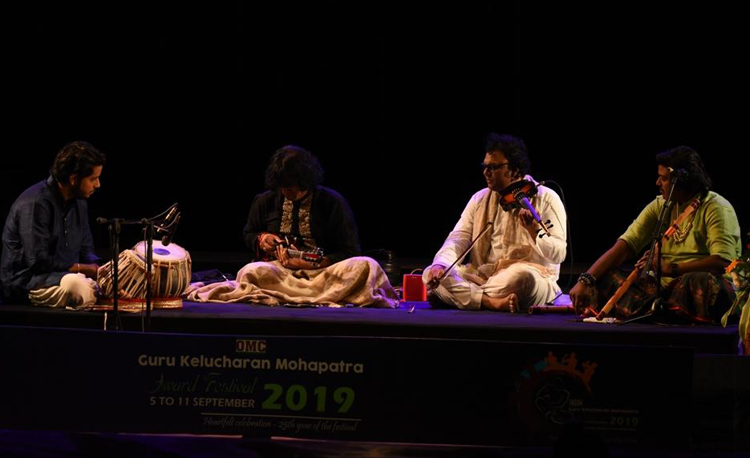
The concluding presentation for the evening was Ahimsa: an Ode to the Father of the Nation by the dancers of Orissa Dance Academy. In this presentation, Gandhi’s life is woven as a poetic appliqué where his ideas and philosophy of life are showcased through music and dance. His ideas of truth, nonviolence, Swadeshi, Swaraj, and self-realization and the events of his life expressed the idea that Gandhi is not simply a political leader from history, but an idea that lives on forever. Borrowing verses by acclaimed poets such as Narsi Meheto, Sumitra Nandan Pant, Harivanshrai Bachchan, and Radhamohan Gadanayak, the dancers exhibited refreshing grace and commendable stage presence, making Ahimsa a delightful encapsulation of a complex narrative. Scripted by Kedar Mishra, and set to the music composition of Ramhari Das, the dance choreography for this presentation was done by Aruna Mohanty. The performances were aided by the brilliant light designing of Debi Prasad Mishra, and the able compering of Dr. Srinivas Ghatuary.
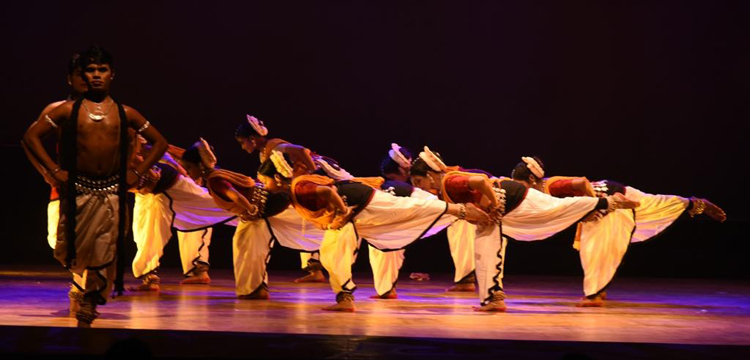
The third day’s first was the Hindustani Music recital by renowned Sarangi exponent Sabir Khan accompanied by young and versatile Tabla player Ishaan Ghosh. They began their recital with an invocation. Sabir Khan’s performance displayed sheer brilliance in musical improvisations with sustained melodic and rhythmic patterns, while Ishaan Ghosh’s effortless percussion play portrayed his versatility and perfection in articulating complex rhythmic patterns. Exploring novel interpretations of Sarangi playing, Sabir Khan delved into the nuances of the beautiful Vachaspati Raag. With its celebratory notes, this raag invoked a feeling of happiness. In their recital, they explored folk and Rajasthani compositions as well.
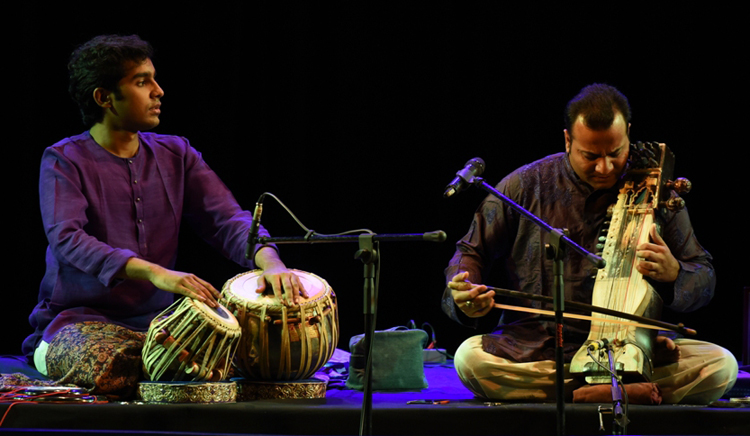

In the only solo presentation of the festival, Niharika Mohanty, a senior disciple of Guru Kelucharan Mohapatra, and founder-director of Guru Shradha, California, USA, presented two dance pieces, Behag Pallavi, a pure dance and Braja ku choro, an Odia Abhinaya. Both pieces have been composed by the legendary Guru Kelucharan Mohapatra. With years of nuanced training under Guruji, Niharika Mohanty’s execution of Behag Pallavi displayed the essence of Guru Kelucharan Mohapatra’s style. This was interwoven with her own creative expression. In her second presentation, Braja ku choro asichi, she beautifully portrayed the role of mother Yashoda trying, like all mothers, to make her baby Krishna to sleep. Her futile attempt to frighten him of a baby-lifter who may come for him does not make an impact.
[adrotate group=”9″]
The concluding presentation for the evening was by eminent Odissi guru, Bichitranda Swain’s Rudrakshya ensemble. They presented Jaha Krishna Saha Kali, a production delving into a deep connection between Krishna (an avatar of Vishnu), and Kali (an avatar of Shakti). The composition explored the many similarities and contrasts between Krishna and Kali. While Krishna secures the cosmos with compassion, Kali maintains the cycle of birth and death of every being residing in it with her ferocity. Set to the music composition of Ramahari Das, rhythm composition of Dhaneswar Swain and the dance direction and choreography of Bichitrananda Swain, the dancers Jagyan, Dushasan, Bichitra, Santosh, Samir, Sanjeev, and Rasmi portrayed this intricate production beautifully with neat footwork, grace, and commendable stage presence, an apt conclusion. The strains of music, especially the tune of Kirtan music, struck a chord in my heart. Each of the dancers in Guru Bichitrananda Swain’s team was in top form. Their body language had the soft movements of a creeper, replete with the correct postures, unique to Odissi and the virile and vibrant tandava movements to express the many facets of Kali, the ferocious female incarnation of Durga.
The 25th OMC Guru Kelucharan Mohapatra Award Festival 2019 on September 7 commenced with Hindustani Vocal recital of Indrani Mukherjee, an accomplished exponent of the Benaras Gharana. She was accompanied on the Tabla by the creative and versatile musician, Apurba Mukherjee and on the harmonium by Gourab Chatterjee and Sachidananda Sahoo on the Tanpura. She presented three compositions through the course of the evening. The first was a khayal in Raag Kedar. This was composed in Vilambit Ek Taal, Madhyam Teen Taal followed by a Tarana. While the Vilambit and Tarana was the composition of her guru, Bhaduri, the medium tempo in between has been the composition of Guru Ramashreya Jha. Her rendition Celebrated the season of monsoon with beautiful lyrics describing the rains, creating musical harmony all through. Her second presentation was a Kajri, in Raag Pilu. The rendition of ‘Kehenva Mano Oh Radha Rani’ highlighted her exceptional musical sensibilities, leaving an indelible impression on the audience. The final presentation was a Bhajan in Raag Hemant. Melodiously interwoven with her individual creative expression. Indrani presented this raag creating a deep and soothing atmosphere for the audience, a perfect conclusion to an evening of harmonious Hindustani music.
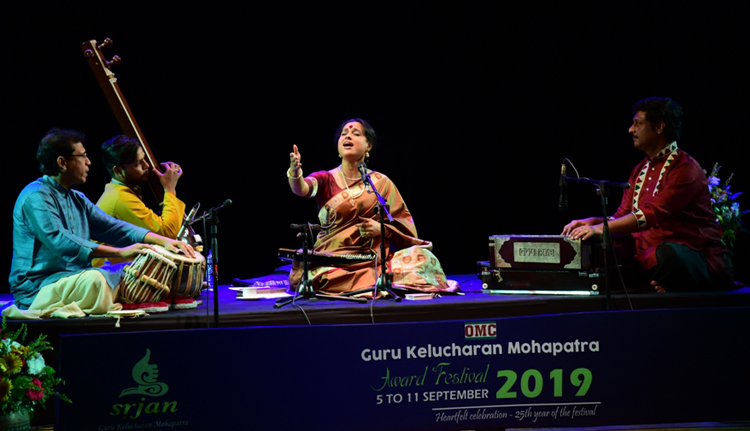
Soor Mandir from Cuttack, led by Jyotsna Rani Sahoo, presented Rasanuraga set to the music composition of Agnimitra Behera and the rhythm composition of Dhaneswar Swain. It portrayed the deep connection between rain and love and explored its many facets. Set to Ragamalika and Talamalika, the dancers presented the production with astounding stage presence.

Nupur run by Niranjan Rout, trained by Guru Pankaj Charan Das, Guru Deba Prasad Das and Guru Hari Nayak( for Mayurbhanj Chhau), presented Khamaj Pallavi and Shiva Stotram . The music was composed by K. Ramarao Patra and rhythm was by Dhaneswara Swain. A mixed group of male and female dancers augured well for the group, it brought out the nature of Shiva’s tandava dance. The dancers had a grip over the Odissi idiom and reflected Deba Prasad Das gharana with sabdraswarapata chantings for the Shiva stotram.
On 10th September the programme began with Odissi music by the gifted Bijay Kumar Jena, a disciple of Kashinath Jena. At Utkal Sangeet Mahavidyalaya he has been under stalwarts like Gopal Chandra Panda, Bhikari Charan Bal, and Ramhari Das. He has also been a disciple of Bhubaneswar Mishra and Raghunath Panigrahi.
[adrotate group=”9″]
He was a star attraction who sang raga Marwa in ek tala. ‘Biraj badhu re’, champu, ‘to chitta re Chandranana’, and Janano ‘He Narayana’ and the natyanga composition of Upendra Bhanja ‘na kar re ramana’ in Bhairavi were proofs of his musical genius.
Jagannath Gopinath scripted by Kedar Mishra was presented by Durgacharan Ranbir on the penultimate day of the festival. The ‘pahandi chaal’, when Lord Jagannath’s chariot is being pulled during Rath Jatra and the ‘gajendra chaal’ were imageries used appropriately. The Jhula assumes a significant motif when Jagannath is taken on a swing and Krishna and Radha is on a swing too. Durga Charan Ranbir had the audience eating from his hand with each and every episode. The marriage of Devaki and Vasudeva; the birth of Krishna at midnight and Vasudev’s escapade with the boy guarded by Shesha, the serpent, on stormy night jubilation in Yasoda’s house; was tellingly told. Deba Prasad Das style is very much alive and kicks in the hands of Durga Charan Ranbir.
Noted Odissi exponent Gajendra Panda’s group Tridhara presented three dance pieces, Mangalacharan, Kirvani Pallavi and Ram Bhajan. Titled Lakshmi Nrusingha Dhyana, the Mangalacharan began with an invocation to Lord Gajanana, and then a prayer to Lakshmi Nrusingha, Lord Vishnu in his half man half lion form, merged with Goddess Lakshmi on his lap. The verses for this presentation have been adapted from Prahalad Natak, the folk theatre of Ganjam district of Odisha. This Mangalacharan featured the hallmark Sabda Swara Pata, a key feature of the Guru Deba Prasad Das gharana, and was set to the music composition of Dr. Gopal Chandra Panda, rhythm composition of Dr. Banamali Moharana and the dance choreography of Dr. Gajendra Panda.
[adrotate group=”9″]
This was followed by a pure dance or pallavi, set to Raag Kirvani, composed by Laxmikant Palit and Dhaneswar Swain on music and rhythm respectively and the dance choreography of Dr. Gajendra Panda. The presentation concluded with a Ram Bhajan, drawn from Nagarakirtana tradition of South Odisha. With the music composition of Dr. Gopal Chandra Panda and the dance composition of Dr. Gajendra Panda, this Bhajan also propounded the narratives of Daskathia, a popular folk form of Ganjam. The dancers of Tridhara displayed energy and neat footwork throughout their performance. Guru Gajendra Panda is a store-house of knowledge. A little more perfection in the execution of dance would make it unparalleled. It should be kept in mind that dancers need to have a maintained and toned figure. With a teacher like Gajendra, the team should be doing excellently. Krishna did not appeal to raikas’ imagination in the absence of a toned body. He needs to have a good bite which only an orthodontist can fix.
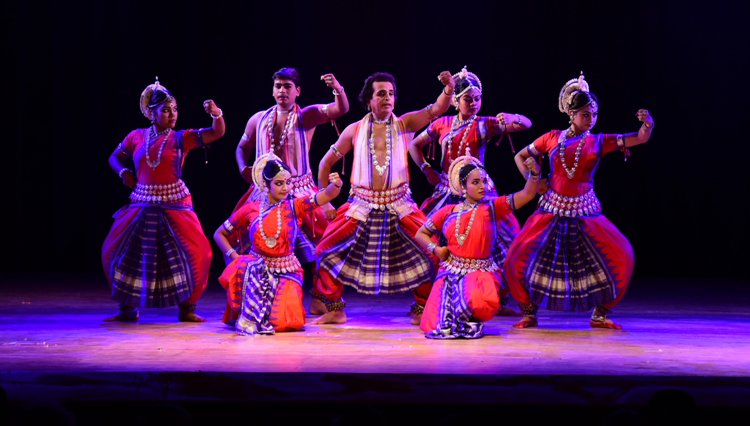
Sarod recital by Debasmita Bhattacharya, ably accompanied by Sandip Ghosh on Tabla. She played Raag Durga usually sung during autumn. Beginning with a short alaap, the composition was a charming amalgam of three sections, beginning with Vilambit Teen Taal in sixteen beats, moving on to Ek Taal, and concluding with a composition in Dhrut. Interwoven with a bandish celebrating the autumnal happening- Durga Puja. Presenting pieces composed by the legendary Sarod exponent, Pandit Buddhadev Dasgupta, Debasmita Bhattacharya’s versatility enabled her to explore a variety of musical nuances, emphasizing her very own individual creative expression. Her ability to switch from presenting Rag Khamaj, which she had planned to Rag Pilu –a composition of her guru –was spontaneous and well rendered. Sandip Ghosh accompanied her with effortless dynamism.
Nupur Dance Academy, under the mentorship of Niranjan Rout, danced Khamaj Pallavi, a pure dance presentation punched with a Shiva Stotram as an Abhinaya piece. Both the presentations have been composed by Niranjan Rout, set to the music composition of K. Ramarao Patra and the rhythm composition of Dhaneswar Swain. Set to Raag Khamaj and Triputa Taal, the dancers presented this Pallavi with neat and crisp movements. Shiva Stotram, celebrated the cosmic dance of Lord Shiva. Seeking salvation through the intervention of the lord was its highlight.
[adrotate group=”9″]
Dr. Ileana Citaristi’s group Art Vision presented the production ‘Akshara -A Dalliance with the Odia Alphabet’. Akshara is a poetic composition which captured the process of learning the Odia alphabet in a mood of gaiety, both as dalliance and also as homage to this rich and ancient language. Beginning with the rituals of commencement of writing in any Odia village by drawing three circles on the dry mud with lime sticks, these initial shapes and shadows of roundness were shown to denote the genesis of the Odia alphabet. Scripted and conceptualised by Devdas Chhotray, and set to the melodious musical composition of Lakshmikant Palit, the dance choreography for this presentation is by Dr. Ileana Citaristi. It featured sand animation by Sudarshan Pattnaik. Simple but Neat footwork and stage presence were hallmarks of the production. The piece was choreographed painstakingly and ought to be taken around schools too.
GKCM award festival provided a platform to Ashok Ghosal’s production ‘Mu’, which envisaged the arrogance of one’s soul. This he explained through mythological characters: Hiranyakasipu, Ravana and Kamsa. A good concept with a flat presentation. The dance style was far removed from the more well-known ones. To make it aesthetically appealing an overhauling is needed in several aspects.
The Silver Jubilee celebration of GKCM award festival culminated with Namami Gange, in which Srjan Guru Ratikant Mohapatra was a winner. Armed with Nityananda Mishra’s Sanskrit text, and the music of Lakshmikant Palit, he worked wonders with his team of svelte performers who practised to the hilt was picture perfect. A moment of wide-eyed appreciation comes to us when we see this ballet-like precision in Indian Classical dance. Shortened movements; smaller chowkas; and of course the well practised graceful tribhangi style made the rasikas gulp down what was served. Ganga’s descent on earth; redemption of Sagar’s sons, who had disturbed Kapil rishi from meditating; Indra’s stealing of the horse; Ganga’s descent; Lord Shiva’s help and finally the present state of polluted Ganga were streamlined with efficiency within a short time duration with a flood of imagination and creativity. The flow of the river; the narration of the story; the visual effects; costumes; cremations; light designs; the music and all else encompassed history, mythology, legends linking it all with the present reality was marvellous.
[adrotate group=”9″]
GKCM award festival is annual happening in Bhubaneswar, awaited by dance lovers with a lot of expectations. Not only did he give scope to the next generation musicians of the country, but he also provided a platform to Odissi gurus of Odisha to showcase their work
The Nalco Award for Guru Kelucharan Mohapatra 2019 went to Guru Harmoham Khuntia for his contribution in Indian Classical music, Guru Durgacharan Ranbir for his contribution in the field of Odissi dance, Dr. Sunil Kothari for his contribution in scholarship and critiquing, Leela Venkatraman for her contribution in the field of dance writing and Avinash Pasricha for his contribution in the field of photography.
Nalco Guru Yuva Pratibha Samman was given to the following: Swapnokalpa Dasgupta (Odissi Dance) Rahul Acharya (Odissi Dance), Rajasri Praharaj (Odissi Dance), Anwesa Mahanta ( Sattriya Dance) and Satyabrata Katha (Odissi Music)




